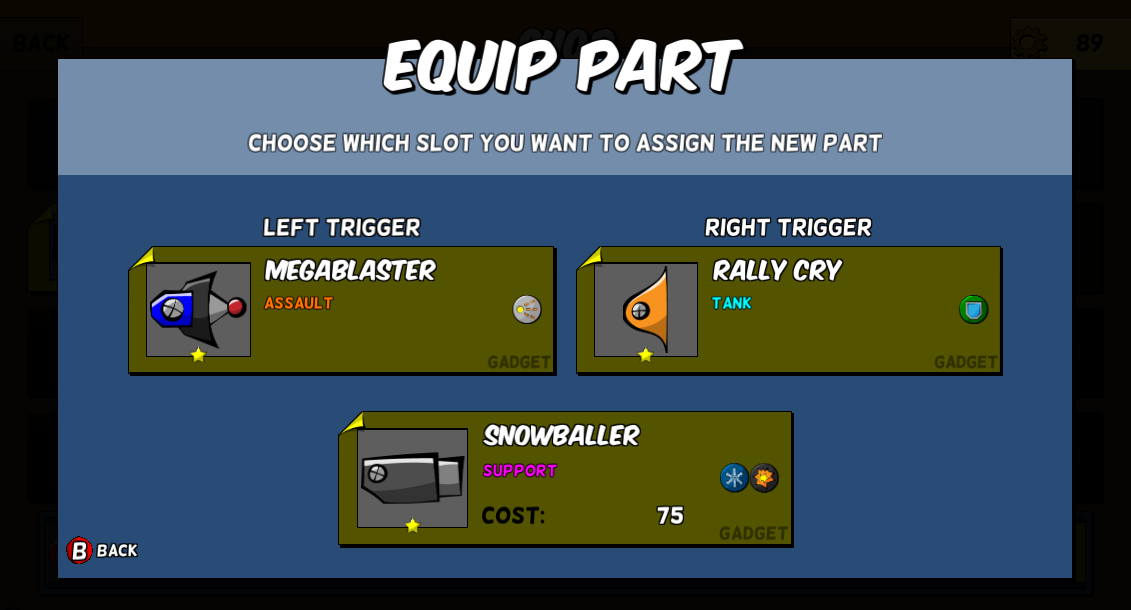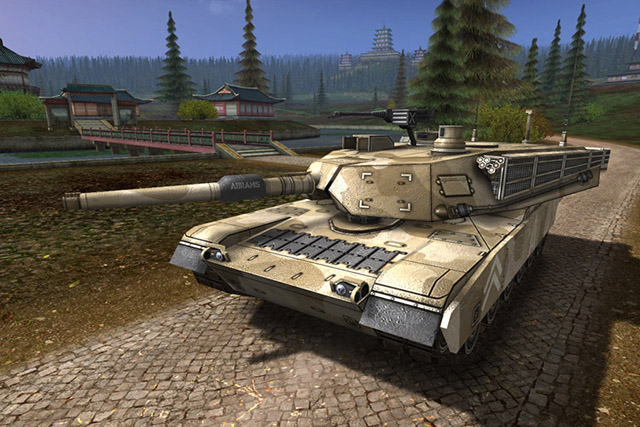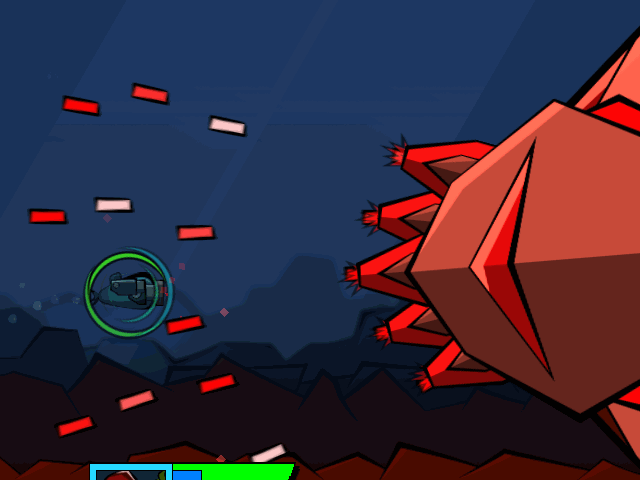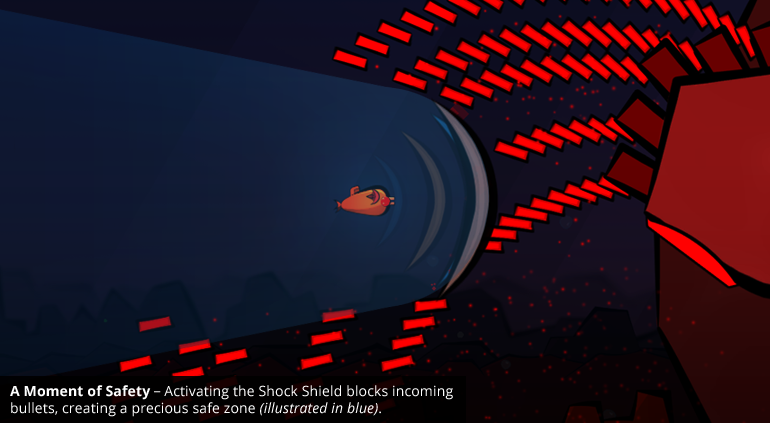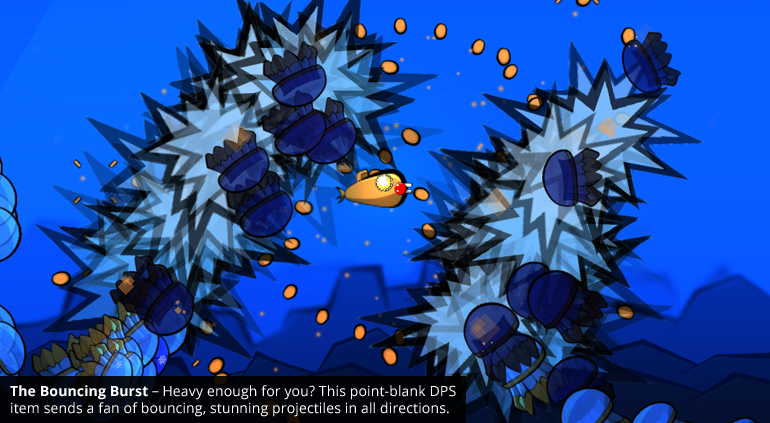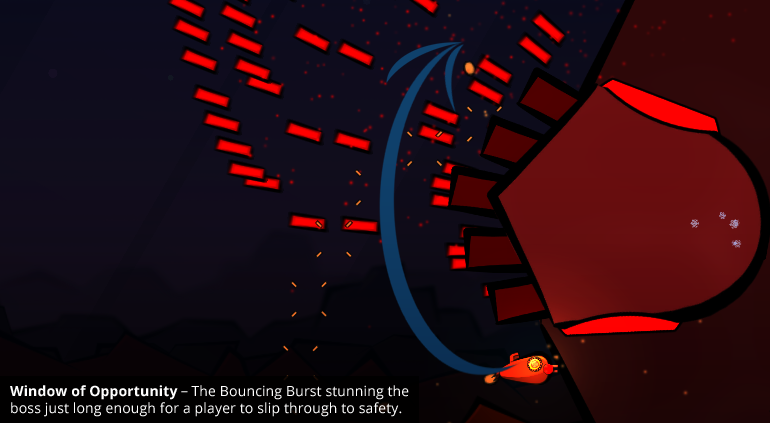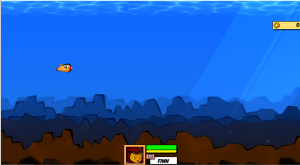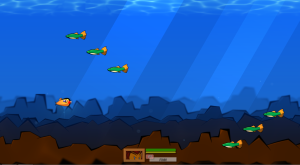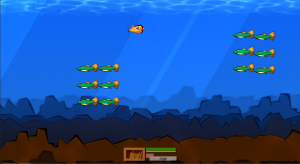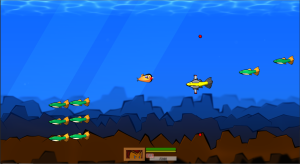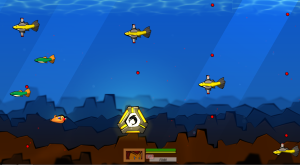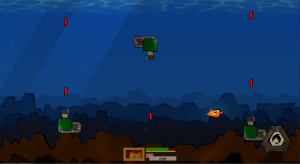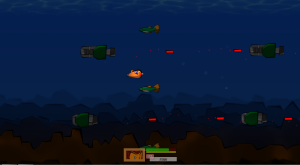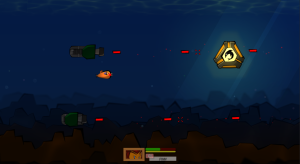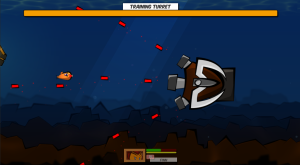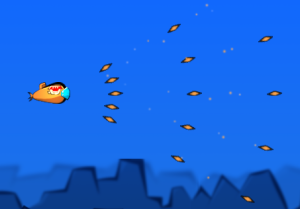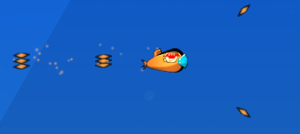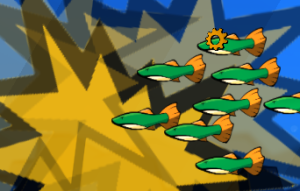Fingeance is a game about teamwork. Or at least, that’s what we’d like to say. The teamwork aspect of our game hasn’t been emphasized as much as we’d like. So, we’re working to change that.
Teamwork Revisited
So what have we done to fix it? First, we’re looking at remaking the starting parts of some of the characters to better accentuate the teamwork aspect of Fingeance right from the beginning. We’ve got a few parts currently in the game that are very teamwork oriented, but they’re not available until later levels, and even then you may not get access to the parts. Having starter parts have more of a cooperative tinge should help players get in a team mindset when they enter the shop for the first time. These new teamwork parts still match the kinds of gameplay we want each character’s ship to have. For example, Finn, the angry leader of the group, has the gadget Rally Cry, which when activated increases the rate of fire of every ship’s cannon. Finn can use this gadget to organize a strong offensive when he sees a point of weakness in enemy patterns (or he can just use it when he’s mad, we won’t judge).
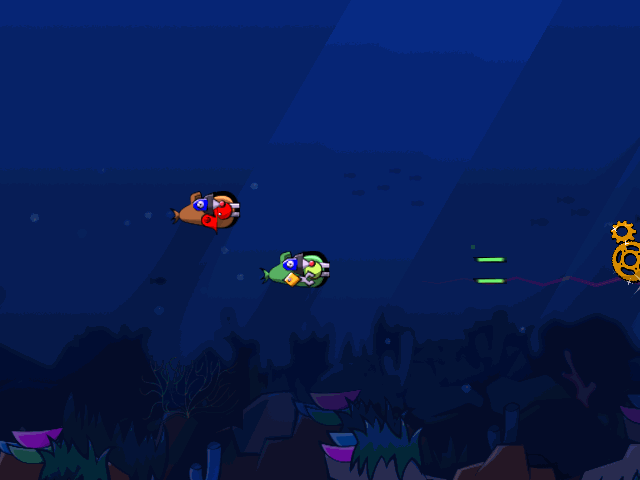
Secondly, we’re working on upping the teamwork strengths of some of the roles you can take in the game. We’ve already done work on tanks in the past, but soon we’ll be taking a look at the other parts of the game. This will involve creating new parts that make new possible cooperative builds. Supports are next!
We’re also working on new enemy and boss encounters that will feel a bit more like raid bosses from popular MMO’s. Not so much to the extent where you’ll be forced to have a tank on your team, but instead having separate objectives for players to coordinate around. Objectives like secondary enemies to kill (like One Tough Puffer’s turrets), or points of high bullet output (The Twins icy fire) help emphasize the kind of teamwork we’d like to see from players.
Equipping Works!
Equipping parts work finally! We’ve added the ability for players to select which gadget they’d like to replace when buying a new gadget. The shop has been updated with additional features and tweaks to maximize player usability.
Bullet Trails
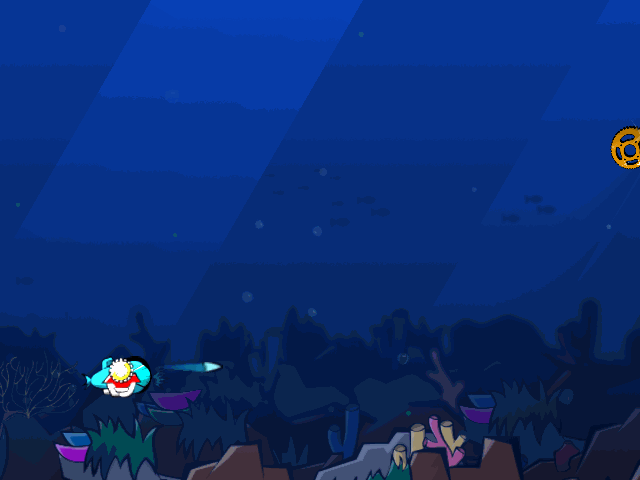
Special bullets now have trails that follow along on their path to destruction. These trails can give extra clarity when shooting really fast bullets, and they just look really cool overall.
Have you felt like teamwork has been a part of your strategizing? We’d love to hear from you. You can comment and follow us here on our blog (we update weekly!), send us a tweet to our Twitter, or comment on our Facebook page.
Hey everyone! First, we at Escape Industries would like to thank you for giving our newest alpha demo of Fingeance a playthrough. We really appreciate it. Working on Fingeance would not be nearly as rewarding without the feedback and support we’ve gotten.
Speaking of feedback, one thing has been coming in loud and clear: player roles (such as Tank, Assault, Support) should be more meaningful. Teamwork should be more interesting. Right now, Fingeance players do rely upon one another, but all too often, that reliance goes like this:
Two of us can deal damage twice as fast as one of us.
Compared to other team-centric games, this is boring, and falls short of Fingeance’s design goals. Over the next few weeks, we’ll be testing ways to add diversity to the team roster. Our first major step is taking a long look at the tank role.
The Tank Role
So, you want to throw yourself in danger, to be the bulwark, the salvation of your comrades. Right now, with just a meager handful of “Tank” parts in the game, you’ve got a hard road ahead of you. On the flipside, if you do pull together a tough, damage-resistant ship, you might find the game suddenly becomes too easy, as formerly terrifying enemies barely make a ding in your impressive HP bar.
We can do better.
So, what is a tank? Generally, a tank’s job is to prevent the other players from taking damage or being attacked. In most games, tanks provide a group with a big, damage-soaking, enemy-taunting behemoth. In some ways, a Shoot-em-up is the tank’s ideal playground. Unlike in traditional action RPGs (see World of Warcraft or League of Legends), a Shoot-em-up tank can literally throw himself in harm’s way to protect his teammates. Each bullet absorbed by the tank creates a little pocket of safety for his allies.
Unfortunately, there’s a problem. Shoot-em-ups are, fundamentally, all about dodging bullets. If you create a character who’s tough enough to absorb bullets, you have a very difficult time providing compelling gameplay for that character. As anyone who’s played a game in “god mode” (where you take no damage from enemies) can attest, being an invincible warrior isn’t nearly as fun as it sounds. So, how do we keep the game exciting and still allow you to play the savior and protect your friends?
Temporary toughness.
We’re working on a number of parts that let you go from zero to hero when it counts. Here are a few work-in-progress parts.
Adaptive Armor
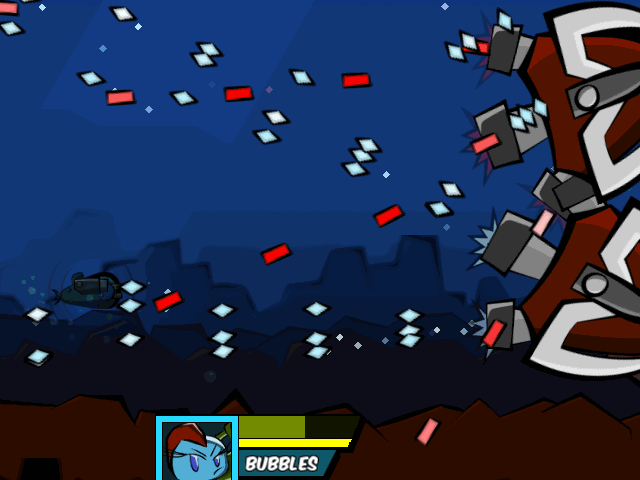
In order to allow players to tank while still needing them to dodge things, we’ve created a few parts that make you temporarily extra-durable. This way, a player would need to look for opportune points in enemy attack patterns to block damage. One example of this is the new Adaptive Armor augment: equipping this augment causes your ship to take significantly less damage for a short time after getting hit.
Shields
Shields are another way to provide ships with temporary tankiness. You might have played with an example already, called Shell Shot, that generates a shield upon input release. The upgraded version of this cannon, Shell Shot Mk. 2, is even better at this as its shield scales with the damage its dealt before release.
We’ve got a handful of other parts like these we’re working on right now. This should make tanks feel powerful, but not ridiculous.
Content Creation at Full Steam!
Since most of the gameplay systems in the game are finished (though, some could use a tune-up), we’ve cranked up content creation to 11. You should see examples of our most recent parts, enemies, and art in the coming weeks. Just like the new tank parts, we’re focusing on creating content that help emphasize roles in the game until we feel we’ve hit a good point.
Any roles you’re really passionate about? We’d love to hear from you. You can find us on Twitter and Facebook, and here on our blog. Feel free to comment below as well!
Last week has been somewhat difficult productivity wise. We’ve all been preoccupied with other projects, and so creation has somewhat been slow. That doesn’t mean we’re empty handed though!
New Shields
Lane introduced you to augments last time. The bulk of our work has been in making augments, but we’ve also introduced a new mechanism that ships can use.
Shields protect a player (or miniboss/boss, possibly) from damage for a duration. They also have a set amount of damage, shown on your health bar, that they can take. Once its damage limit has been reached, the shield breaks and your ship takes regular damage again. Think of a shield from a game like League of Legends; that’s pretty much how shields work here.
Augments and Other Parts
With this addition, we’ve added a few tentative parts as experiments. These may not be in the final game, but they’re definitely proofs of concept.
Panic Button – Augment
• -25 health
• Large, long lasting shield is deployed when the player reaches 20% of their total health.
• Useful for beginner players, or those player who like to take large risks.
Energy Chalice – Augment
• Energy regeneration is increased based on the amount of energy your ship is missing.
• Regeneration scales based on the amount of missing health, not a percentage (missing 200 energy will increase regen twice as much as missing 100 energy).
Shell Shot – Cannon
• Provides the player with a shield when the player stops shooting after a period of time.
• Lower rate of fire and range, but damaging bullets
Bloodlust – Augment
• Ship is healed a very small amount each time the player hits a target.
As you can see, adding in the ability to make an augment or add a shield to players gives us more design space to work with. Shields in particular are very useful effects for tanks. Keep in mind, a player can add as many augments as his/her ship has room for, so feel free to experiment!
In a previous version of our game (we’ve been doing this for nearly a year now), every cannon came with an alternate fire option. This was back when different kinds of hulls existed for the player to buy. Alternate fire shots were accessed by holding the shoot button down for a period of time, which depended on the cannon chosen. Back then you had tap to shoot constantly.
We had decided on this option for players as a method of increasing uniqueness in the cannons. Alternate fire would add interesting choices while playing the game, and keep each cannon different from others by having a powerful shot special to that cannon. It did its job well: we felt like charging up a cannon gave players decisions that could feel special without making the cannon complicated, in addition to having to make a conscious decision to lose out on dps in order to gain access to the alternate fire shot.
Unfortunately, we ran into the downsides of alternate fire. In our playtests, we noticed players opting not to use them. Players had more fun just shooting. Some players also found it tedious to have to mash the button to continually fire. The input was also not optimal; players could not constantly press the shoot button with the correct timing every time it was possible. This was especially problematic with the varying rates of fire, making us unable to make fast shooting cannons for fear of causing the player to hurt their fingers mashing the shoot button.
We came up with a solution: have the alternate fire charge while the player is not firing, and allow players to hold the button to shoot. This resolved many of the problems of the original alternate fire system. It was also more obvious to players that the weapon was charging since it would happen automatically in a game (there are some times when firing is discouraged, like in a minefield). Currently, we don’t have many finished cannons with an alternate fire, as we’ve noticed that novice players still don’t use them and we’ve been focused on the earlier parts for the demo. The Ice Trident is an example of such in the demo (in the updated build). Try it out there, and let us know what you think!
The Shock Shield.
This thrumming bulwark of porpoise-punishing power might be the marquee item for Fingeance, and we’ve all but ignored it on this site. Stephen wrote a primer on it here, but it deserves a second look.
You see, the Shock Shield isn’t the only defensive item in Fingeance. Once done, the game will be packed with them. But right now, the Shock Shield is king. Check out this stopping power:
Let’s take two lessons from that image.
First, top-difficulty Fingeance can be insane. Just look at that bullet output. For anyone steeped in shoot-em-up culture, keep in mind that the player submarine’s hitbox is the entire submarine. That means dodging attacks like this is just as hard as it looks.
Second, players can overcome this difficulty by working together. A team carrying a Shock Shield plays much differently than a team without, since the shield provides brief moments of near-total protection. So, with all that power, when would you ever not play with a Shock Shield? To find our answer, let’s look at a few facts about Fingeance enemies:
- Many enemies change behaviors as they survive, increasing their threat over time.
- Several enemies enjoy summoning minions, increasing their threat over time.
- Most bosses have some sort of Soft Enrage mechanic, increasing their threat over time.
See the subtle commonality? High-difficulty Fingeance is about threat assessment and management. When you can put down the threat fast, you’ll save your team a lot of pain down the road. The tradeoff is damage vs. safety. The Shock Shield provides a lot of safety, but no damage. When you bash a foe with the Shock Shield, you shock them (stunning them briefly), but put them no closer to their demise.
Further – and here’s where we get to the delicate balancing act of Fingeance part design – many offensive items can be used in defensive ways. The Shock Shield is merely the easiest to use.
Introducing the Bouncing Burst:
This thing is capable of massive area-of-effect mayhem. The catch? You have get up close to do it.
With this part, we’re asking for a player to put it all on the line. Sure, it can be worth it (when our demo hits, try sneaking inside the Jellyfish Queen’s body, then unleashing this baby. Ouch.), but when you’re that close to a boss, things can turn sour fast. Worse, the Bouncing Burst doesn’t seem to offer any protection. Sure, your team needs the damage, but which part do you choose?
Decision-making in Fingeance relies on the needs of your team, and also on their skill. Remember how I said the Shock Shield was only the easiest defensive item? Basically defensive training wheels? Well, check this out:
[Editor’s Note] – This shot was taken by playing one-handed for the purpose of screenshotting. The Bouncing Burst can create a pause in the bullet stream large enough to allow passage without quite as much difficulty as this image would suggest.
There’s that same boss, executing the same attack as above. Now, the burst’s brief stun effect allows the player to (just barely) sneak through without taking damage. As players climb through the higher difficulties, we expect a certain degree of scrappiness. To battle the enemy superpowers – devastating attacks and growing threat – you’ll need to maximize every part, offensively and defensively.
As we careen toward our June 1st demo, we’ll be adding polish and balance to these parts and others. We can’t wait to see how you’ll put them to use.
In preparing for Fingeance’s demo release (out June 1st!), I’ve been updating older chunks and creating a new beginner level as an introduction to the game for newer players. If you’ll bear with me, I’d like to go over what a beginner level for Fingeance looks like.
Right in the beginning, the player is dropped into an empty ocean. The players won’t see an enemy for several seconds, and will not be in danger of taking damage even if they don’t move for quite a while. This allows the players to experiment with the controls before having to deal with any consequences. A beginner can feel free to make mistakes, spam their gadget, shoot off into nothing, and be safe from any enemy retaliation.
After the introduction, players are introduced to the simplest enemies in the game, Mini-guppies, in an easy to deal with pattern. The guppies are placed in such a way to encourage movement. Players with an understanding of the game will move downwards while shooting to hit each of the first group of guppies. Beginner players (who maybe don’t fully grasp shooting) will be able to easily avoid the guppies.
A wall of guppies follows after. These guppies are a little harder to avoid, but still easy enough to deal with. It’s a more interesting enemy pattern for all players, new or old, to go through.
20 seconds into the level, the players are introduced to the first shooting enemy, Guppy Gunners. Beginner players can avoid these by slipping between its shots. More advanced players will power through them.
Part way through the Guppy Gunner section is a Treasure Chest. This is meant as a reward for more advanced players by giving them extra scrap for avoiding or killing the gunners. Beginner players can avoid the Treasure Chest without having to worry though, as it is not a requirement.
Afterwards is an intro to the turrets. Some of the chunks in the game play out somewhat like an obstacle course, so this is a small taste of that for beginners. Note the Treasure Chest in an inconvenient location.
Here is a more advanced version of a turret pattern. The turrets are set up so that the level is split into three different lanes. Teams can split up and access each of the lanes, and can easily hit all of the upcoming enemies. Advanced players can slip between each lane too, if they’re up to the challenge.
Near the end of this level, right before the boss encounter, is another Treasure Chest. It’s a little difficult to grab for beginners, but it’s a nice heal for more experienced players before the boss.
The boss of this beginner level is another fairly simple encounter (compared to other boss encounters in the game) with a simple “target furthest player” attack pattern. An easily exploitable pattern for advanced players, and a manageable threat for beginners.
That’s one of the beginner levels we’ve got going for the demo release. The beginner levels (at least for the demo) work differently from chunks because we wanted more control over how players experienced it. Each level will be randomly chosen when the team starts the game.
Hey folks! It’s that time of the year where the more exciting and fun stuff (like this blog…) has to get put on the backburner for the more important and boring things (like finals…). Unfortunately, I haven’t been able to do much game design work this past week. This blog post and likely next week’s are going to be sparse.
What little work I have done has been relatively unfruitful; I’ve been working on designing some new parts for Fingeance, but for the most part the designs haven’t panned out. One successful part is the Gatling Gun: a high damage cannon that increases in fire rate the longer it has been firing. It should be familiar to players of FPS’s or the like. The faster the cannon is shooting, however, the slower your ship will move. It’s a high risk, high reward kind of weapon; control over your ship’s speed and damage with this part will give you higher damage over time than other weapons, if you can handle the slower movement speed.
A lot of my game design work this week has been devoted to making a simple cannon with a similar playstyle to the Gatling Gun. The Gatling Gun’s play pattern is based on finding ideal points to deal large amounts of damage safely, but I feel like it is a more difficult weapon to get a hold of. Novice players will likely constantly hold the fire button down, resulting in a frustrating experience with the lower movement speed. What I would like to do is develop a cannon that has that same play pattern, but in more simple package, although if you also like other type of games such as slot games, you can visit studybreaks.com to find great options to play and also make some money.
Hopefully, next week I’ll have much more exciting game design news to bring you all. Until then, may the grading curves be ever in your favor. I certainly hope they will!
This past week, I’ve been looking at the movement options we have in Fingeance currently. This blog post is gonna get pretty in depth in some of our design philosophies and understanding of our game, as well as the history of this game’s creation a little. Hopefully you get something interesting out of it.
(Quick note: Lane and I have decided to switch our blog posts around. Lane will be posting on Mondays and I will be posting on Fridays starting this week.)
Initially, player ships had three different parts that could be attached: cannons, gadgets, and hulls. Hulls contained all of a player’s movement and health, as well as had an additional action we called a “defense effect.” These effects ranged from giving the player a shield around him/her ship that protected it from bullets, to a dash that let players move around the screen more quickly. We realized that adding these additional options in the game made customization more complicated. It also made designing unique parts a harder ordeal than we would have liked. Adding in an additional action for players made it necessary for the complexity of each action to be smaller, and we didn’t like the direction that led us.
So, we decided to remove hulls as an option for customization. The stats gained from hulls were moved to cannons and gadgets. However, we were still considering leaving the “defense effect” action in the game by making it the same for all players. This would still give players more ability, but since the action would be consistent across the board, cannons and gadget complexity wouldn’t have to change. As we had difficulty making shields work in the past and liked the gameplay of a dash, we made dashes an action all players can take.
Dashes in previous iterations of the game varied a bit. There weren’t a ton in the game when we decided to remove hulls, but there were three kinds of dashes: a dodge (a dash that made you intangible to bullets when active), a dash (a regular dash with a cooldown), and hyperdash (a regular dash with no cooldown). Each of these dashes came with their own sets of problems. The dodge was satisfying to use when it worked, but was not clear when the intangibility was active and was fairly situational. The dash was clear and less situational, but wasn’t satisfying to use. The hyperdash was fun to use, but it overtook regular movement because it was so safe.
In my analysis, I looked at why we wanted to give every player a movement option, and what that would add to our game. I looked to many different sources for this, including platformers such as a Mario game. In the 2D Mario games, they have a run mechanic that lets players move faster while the button is held down. I actually implemented a run mechanic in our game to see how it would feel. After testing this run mechanic, and retesting the older dashes, we felt that giving movement options to each player’s ship was not necessary, and didn’t add much to the game. We’ve since removed them, but that doesn’t mean we can’t revisit it later to add to a gadget.
Thanks for reading this! It seems like a lot of obvious stuff, but sometimes as a creator you need to step back and look at what you’re making.
It’s been a little while since we’ve gone over parts in Fingeance, but since I’ve been working out a few designs I wanted to share some of the more finalized ones with you. Keep in mind that they may not be exactly like this in the final product.
Frenzy Engine

This gadget will increase your ship’s rate of fire dramatically while it is active. It’s a great gadget for players with strong cannons, looking to deal loads of extra damage on the team’s foes. This also has excellent synergy with cannons that can use the increased rate of fire particularly well, such as a weapon that deals increased damage on every other shot. Some of our parts can be kind of complex, but this part is really simple for newer players to grasp, which is nice as well.
Skirmisher
Neutral pattern
Forward pattern
Backward pattern
The Skirmisher is a cannon that changes firing patterns based on the player’s movement. The shooting patterns are still in flux, but currently shooting while not moving fires in a very wide cone, hitting multiple targets. Moving forward concentrates your fire to right in front of you, loading all of your damage to a small area. Going backwards fires several shots behind you, and in two wide angles in front. Mastery of this cannon will involve a strong understanding of the capabilities of each pattern. Each pattern is situational, but generally players will be encouraged to move forward to concentrate their damage on a specific group of enemies. The other patterns give players other options in case moving forward is not viable at any time.
Bomb Launcher

Example of explosion
It works just like the name implies: this gadget shoots out a bomb that on impact with an enemy will explode in a large radius. Helpful for those pesky guppies in large groups, and powerful enough to deal great burst damage to the tougher foes. Another simple gadget, but because of its high damage burst, it can’t be used very frequently. Best to save this gadget for when you really need it.
That’s it for this week! I’ve been working on Fingeance’s movement options recently, so I’ll go over what I mean by that next week.
So guppies, you love ’em, you hate ’em. They aren’t much of a threat though. Even in large groups, you can just plow through them with enough damage (or a cooperative team!). But what happens when you strap a couple of cannons on their sides?
Enter the guppy gunners. These guys move slightly faster and are a bit tougher than regular guppies. Oh, and they have big cannons installed. That’s their big hook: these guys are kinda hard to avoid if you just leave them alone because those cannons can be pretty difficult to get past. If you have someone who can block bullets, stun/slow enemies or just outright kill a guppy gunner, they’re not much of a problem. In general, it would benefit the team to deal with a guppy gunner quickly before they get close enough to be an immediate threat.
Where do these guys fit into a level of Fingeance though? They have the benefit of not being a drastic and immediate threat when they show up on screen. They also wall off progress in a minor way if not dealt with. Therefore, they’re strong when placed in an area with more imminent threats in the level. For example, if you put these guys in a level with a bunch of heat seeking missiles it would be harder to prevent them from getting close to your team, as the team would have to deal with the missiles first. Guppy gunners provide more of a challenge the longer they are in the level, as you have less space to deal with them.
Next time, I’ll discuss some more part designs I’ve been working on this week. I hope to see you there!

